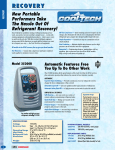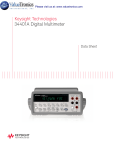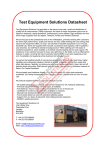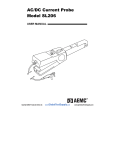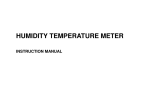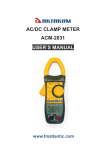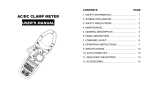Download Agilent Technologies 34134A User`s guide
Transcript
34134A.book Page 1 Wednesday, March 25, 2009 4:09 PM User’s Guide Publication number 34134-90001 April 2009 For Safety information, Warranties, Regulatory information, and publishing information, see the pages at the back of this book. © Copyright Agilent Technologies 1999, 2009 All Rights Reserved. 34134A AC/DC DMM Current Probe 34134A.book Page 2 Wednesday, March 25, 2009 4:09 PM Contents Inspect the probe . . . . . . . . . . . . . . . . . . . . . . . . . . . . . . . . . . Description . . . . . . . . . . . . . . . . . . . . . . . . . . . . . . . . . . . . . . Compatibility . . . . . . . . . . . . . . . . . . . . . . . . . . . . . . . . . . Control and Connector Identification Information . . . . . Specifications and characteristics . . . . . . . . . . . . . . . . . . . . . Electrical Specifications . . . . . . . . . . . . . . . . . . . . . . . . . Environmental Characteristics. . . . . . . . . . . . . . . . . . . . . Mechanical Characteristics . . . . . . . . . . . . . . . . . . . . . . . Safety Specifications . . . . . . . . . . . . . . . . . . . . . . . . . . . . Operation . . . . . . . . . . . . . . . . . . . . . . . . . . . . . . . . . . . . . . . Calibration . . . . . . . . . . . . . . . . . . . . . . . . . . . . . . . . . . . . . . Repair . . . . . . . . . . . . . . . . . . . . . . . . . . . . . . . . . . . . . . . . . . To check/replace the battery . . . . . . . . . . . . . . . . . . . . . . Cleaning the probe. . . . . . . . . . . . . . . . . . . . . . . . . . . . . . Declaration of Conformity . . . . . . . . . . . . . . . . . . . . . . . . . . 2 3 3 3 4 4 5 5 6 7 8 8 8 8 13 Inspect the probe ❏ Inspect the shipping container for damage. Keep a damaged shipping container or cushioning material until the contents of the shipment have been checked for completeness and the probe has been checked mechanically and electrically. ❏ Inspect the instrument. • • 2 If there is mechanical damage or defect, or if the probe does not operate properly or pass performance tests, notify your Agilent Sales Office. If the shipping container is damaged, or the cushioning materials show signs of stress, notify the carrier as well as your Agilent Sales Office. Keep the shipping materials for the carrier’s inspection. The Agilent office will arrange for repair or replacement at Agilent’s option without waiting for claim settlement. 34134A.book Page 3 Wednesday, March 25, 2009 4:09 PM 34134A AC/DC DMM Current Probe The 34134A Current Probe measures low DC or AC from 10 mA to 50 A DC, 40 A AC. This battery-powered clamp-on probe may be used with digital multimeters, voltmeters, or other voltage-measuring instruments. The probe jaws clamp around the conductor under test, allowing current measurements without breaking the circuit. Hall sensor technology senses the magnetic field produced by the current measured, and generates a millivolt DC or AC output signal. The narrow jaw is designed for optimum use in crowded wiring in industrial and automotive environments. Compatibility The 34134A Current Probe is compatible with any DMM, or other voltage measuring instrument which has the following features: • Range and resolution capable of displaying 1 mV of input. • Voltmeter accuracy (uncertainty) of 0.75% or better to take full advantage of the accuracy of the probe. • Minimum input impedance of 100 k Ω (1 V/A range) or 10 k Ω (10 mV/A range). • Input jacks that accept 4mm shrouded banana plugs. Zero Adjust Knob Range Selection Switch Power Indication LED ∅ = 11.8mm Battery Compartment Cover Control and Connector Identification 3 34134A.book Page 4 Wednesday, March 25, 2009 4:09 PM 34134A AC/DC DMM Current Probe Specifications and characteristics Specifications and characteristics Operating and environmental characteristics of the 34134A Current Probes are shown below. Electrical Specifications Current Range Output Signal (AC/DC) Accuracy* 1 V/A Range (1 mV/mA) DC: 10 mA to 2 A AC: 10 mA to 1.5 A 1 mV/mA (2 V @ 2 A) ± 2% reading ± 5mA Frequency Range DC to 8 kHz @ -3 dB Phase Shift DC to 65 Hz: 1 ° Minimum Input Resistance 100 k Ω of Instrument Noise DC to 1 Hz: 1.5 mV 1 Hz to 10 kHz: 14 mV 0 kHz to 100 kHz: 18 mV Slew Rate @ 5 A 120 mV/ µ s 10 mV/A Range DC: 100 mA to 80 A AC: 100 mA to 60 A 10 mV/A 500 mA to 50 A DC/40 A AC: ±4% reading ±220 mA 50 to 80A DC: ±12% reading 0 to 60A AC: ±12% reading DC to 8 kHz DC to 65 Hz: 1 ° 100 k Ω DC to 1 Hz: 15 µ V 1 Hz to 10 kHz: 140 µ V 0 kHz to 100 kHz: 180 µ V 5.5 mV/ µ s * Accuracies are given for an ambient temperature of 23 °C ±3 °C, relative humidity of 20 to 75%, conductor centered in jaw window, probe zeroed, no hysteresis in DC, DC to 40 to 100Hz sine wave (1mV/ mA range) or DC and 40 to 1 kHz sine wave (10mV/A range), 1 minute warm-up, battery at 9V, appropriate load impedance, magnetic field <40A/m and no common mode. 4 34134A.book Page 5 Wednesday, March 25, 2009 4:09 PM 34134A AC/DC DMM Current Probe Specifications and characteristics Typical Frequency Response Curve Voltage vs Frequency Response Curve Environmental Characteristics Operating Temperature 0 to 50°C Storage Temperature -30 to 80°C Operating relative 0 to 50 °C, 0 to 85% relative humidity humidity Temperature Coefficient 800 ppm per °C +10 mA/°C typical from -10 to 50°C Altitude Operating: 0 to 2000 m Non-operating: 0 to 12,000 m Mechanical Characteristics Zero Adjustment Maximum cable diameter Dimensions Weight Color Material Output Cable 20 turn potentiometer 11.8 mm 67 x 231 x 36 mm 330g with battery Grey Fiberglass charged polycarbonate 1.5m double insulated lead with shielded banana plugs 5 34134A.book Page 6 Wednesday, March 25, 2009 4:09 PM 34134A AC/DC DMM Current Probe Specifications and characteristics Safety Specifications Working voltage Case protection Drop test Mechanical shock Vibration ! 600 V CAT III IP20 per IEC 529 1m according to IEC 68-2-32 100 G: test per IEC 68-2-27 Test per IEC 68-2-6 frequency range 10 Hz to 55 Hz, amplitude: 0.15mm This symbol signifies that the 34134A AC/DC DMM Current Probe is protected by double or reinforced insulation. Only use specified replacement parts when servicing the instrument. This symbol signifies CAUTION! and requests that the user refer to the user manual before using the instrument. WARNING SHOCK HAZARD! • Connect the probe to the DMM or voltage measuring instrument before clamping ! the probe around a conductor. • Never use the probe on circuits rated higher than 660 V. • Never leave the probe clamped around a conductor while not connected to a voltage measuring instrument or DMM. • Carefully center the conductor inside the probe jaws and make sure that the probe is perpendicular to the conductor before closing the jaws. • Avoid, if possible, the proximity of other conductors which may create noise. • Check the magnetic mating surfaces of the probe jaws; these should be free of dirt, rust, or other foreign matter. • Do not use a probe which is cracked, damaged or has defective leads. 6 34134A.book Page 7 Wednesday, March 25, 2009 4:09 PM 34134A AC/DC DMM Current Probe Operation Operation 1 Connect the probe to the multimeter or other instrument. CAUTION Be sure to observe the polarities: red = positive terminal, black = common terminal. 2 Select the multimeter range which best corresponds to the measured current. For better reading stability, you may use the DMM 2 Volt range and let the probe “warm up” for one minute before zeroing. The Current Probe has a dual output, DC V output in DC and AC V output in AC. • The “1 V/A” range has an output signal of 1 mV/mA AC/DC with an output of 2 volts representing 2 amps present in the conductor being measured. • The “10 mV/A” range has an output signal of 10 mV/A AC/DC with an output of 500 millivolts representing 50 amps present in the conductor being measured. 3 Zero the probe in DC and in DC coupled AC measurements. When the 34134A Current Probe has been used for a current measurement and then removed from the conductor, a small amount of residual magnetism often remains in the core. This residual magnetism will cause the voltmeter to show a small DC reading even though there is no current passing through the jaws of the probe. The residual magnetism should not cause a problem for AC current measurement because the AC voltage function in most multimeters is AC coupled. DC offset caused by the residual magnetism will contribute to reading errors, but can be minimized by using the zero adjust knob to show a reading of 0 ± a few counts on the multimeter (probe not clamped on a conductor). There will always be some instability and noise generated by the Hall sensor, the earth magnetic field and environmental noise. This is particularly noticeable on the most sensitive range, 1 V/A (1 mV/mA), where you may have up to 5 mV of uncertainty, which cannot be “zeroed out.” “Zero” the probe while it is connected to the DMM and on the range to be used. Let the probe warm-up for one minute before zeroing. Turn the zero adjustment knob until the probe is zeroed. 4 Observe the output polarities for DC measurement. 5 Clamp the probe on the conductor to be measured and read the current flowing directly on your meter. The output of the probe is 10 mV/A AC/DC or 1 mV/mA AC/DC. If your meter indicates a negative reading during DC measurements, this simply means that the current flow is in the opposite direction of the arrows marked “I” on the probe or that the probe connections are reversed (polarity). 6 After measurement, turn the probe OFF. 7 34134A.book Page 8 Wednesday, March 25, 2009 4:09 PM 34134A AC/DC DMM Current Probe Calibration Calibration To guarantee that your instrument complies with the factory specifications, we recommend that the 34134A Current Probe be submitted to your local Agilent Service Center at one year intervals for recalibration, or as required by other standards. Repair This probe contains no user serviceable parts. Please return to your local Agilent Service Center for repair. To check/replace the battery When the probe is turned on, the green LED should light up. If not, replace the 9 V battery. 1 Disconnect the probe from the circuit and the DMM. 2 Turn the probe “OFF.” 3 Unscrew the battery compartment screw and pull out the battery compartment cover. 4 Replace the battery and put the cover back up. CAUTION Do not replace the battery while the probe is in use. Cleaning the probe Be sure that the mating surfaces of the jaw are free of dirt or foreign matter. If they are rusted, gently clean with a soft, lightly oiled cloth. 8 34134A.book Page 0 Wednesday, March 25, 2009 4:09 PM © Agilent Technologies 1999, 2009 All Rights Reserved. Reproduction, adaptation, or translation without prior written permission is prohibited, except as allowed under the copyright laws. Restricted Rights Legend. Use, duplication or disclosure by the U.S. Government is subject to restrictions as set forth in subparagraph (c) (1) (ii) of the Rights in Technical Data and Computer Software clause at DFARS 252.2277013 for DOD agencies, and subparagraphs (c) (1) and (c) (2) of the Commercial Computer Software Restricted Rights clause at FAR 52.22719 for other agencies. Document Warranty The information contained in this document is subject to change without notice. Agilent makes no warranty of any kind with regard to this material, including, but not limited to, the implied warranties of merchantability or fitness for a particular purpose. Agilent shall not be liable for errors contained herein or for damages in connection with the furnishing, performance, or use of this material. Product Warranty This Agilent product has a warranty against defects in material and workmanship for a period of three years from date of shipment. During the warranty period, Agilent will, at its option, either repair or replace products that prove to be defective. For warranty service or repair, this product must be returned to a service facility designated by Agilent. For products returned to Agilent for warranty service, the Buyer shall prepay shipping charges to Agilent and Agilent shall pay shipping charges to return the product to the Buyer. However, the Buyer shall pay all shipping charges, duties, and taxes for products returned to Agilent from another country. Agilent warrants that its software and firmware designated by Agilent for use with an instrument will execute its programming instructions when properly installed on that instrument. Agilent does not warrant that the operation of the instrument software, or firmware will be uninterrupted or error free. Limitation of Warranty The foregoing warranty shall not apply to defects resulting from improper or inadequate maintenance by the Buyer, Buyer-supplied software or interfacing, unauthorized modification or misuse, operation outside of the environmental specifications for the product, or improper site preparation or maintenance. No other warranty is expressed or implied. Agilent specifically disclaims the implied warranties of merchantability or fitness for a particular purpose. Exclusive Remedies The remedies provided herein are the buyer's sole and exclusive remedies. Agilent shall not be liable for any direct, indirect, special, incidental, or consequential damages, whether based on contract, tort, or any other legal theory. Assistance Product maintenance agreements and other customer assistance agreements are available for Agilent products. For any assistance, contact your nearest Agilent Sales Office. Certification Agilent certifies that this product met its published specifications at the time of shipment from the factory. Agilent further certifies that its calibration measurements are traceable to the United States National Institute of Standards and Technology, to the extent allowed by the Institute's calibration facility, and to the calibration facilities of other International Standards Organization members. 34134A.book Page 1 Wednesday, March 25, 2009 4:09 PM Safety This apparatus has been designed and tested in accordance with IEC Publication 1010, Safety Requirements for Measuring Apparatus, and has been supplied in a safe condition. To ensure safe operation and to keep the product safe, the information, cautions, and warnings in this operating manual must be heeded. In addition, note the external markings on the instrument that are described under "Safety Symbols." Safety Symbols ! Instruction manual symbol: the product is marked with this symbol when it is necessary for you to refer to the instruction manual in order to protect against damage to the product. Hazardous voltage symbol. Earth terminal symbol: Used to indicate a circuit common connected to grounded chassis. This symbol signifies that the 34134A AC/DC DMM Current Probe is protected by double or reinforced insulation. Only use specified replacement parts when servicing the instrument. WARNING The Warning sign denotes a hazard. It calls attention to a procedure, practice, or the like, which, if not correctly performed or adhered to, could result in personal injury. Do not proceed beyond a Warning sign until the indicated conditions are fully understood and met. About this edition This is the 34134A AC/DC DMM Current Probe User’s Guide. Publication number 34134-90001, April 2009 Printed in USA. Print history is as follows: 34134-90001, April 2009 34134-90001, Nov. 1999 CAUTION The Caution sign denotes a hazard. It calls attention to an operating procedure, practice, or the like, which, if not correctly performed or adhered to, could result in damage to or destruction of part or all of the product. Do not proceed beyond a Caution symbol until the indicated conditions are fully understood or met. New editions are complete revisions of the manual. Many product updates do not require manual changes; and, conversely, manual corrections may be done without accompanying product changes. Therefore, do not expect a one-to-one correspondence between product updates and manual updates.










